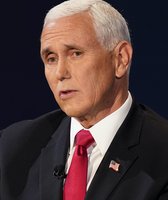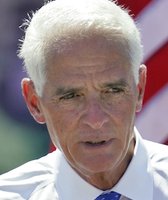Stand up for the facts!
Our only agenda is to publish the truth so you can be an informed participant in democracy.
We need your help.
I would like to contribute
Editor's note: This story is part of a series highlighting special issues in light of the presidential election. This installment looks at tax policy. Previous installments have looked at Medicare, the state of the economy, immigration, and Iraq and Afghanistan. Read our previous fact-checks on taxes.
President Barack Obama made this charge at the first presidential debate: "Gov. Romney’s central economic plan calls for a $5 trillion tax cut, on top of the extension of the Bush tax cuts."
Not so, Mitt Romney said, repeatedly: "First of all, I don’t have a $5 trillion tax cut. … I’m not looking to cut massive taxes and to reduce the revenues going to the government. … I’m not looking for a $5 trillion tax cut."
So which is it?
Romney wants a 20-percent across-the-board tax cut for all taxpayers, which on its own would total $5 trillion over 10 years. But Romney says the cuts won’t add to the deficit because he’ll make up for it by eliminating some of the tax code’s deductions, exemptions and exclusions.
Which tax breaks does he want to get rid of? He won’t say.
Romney’s silence makes fact-checking claims about his tax plan difficult. PolitiFact rated Obama’s statement that Romney wants a $5 trillion tax cut as Half True.
But Romney’s lack of specificity also makes it difficult for voters.
Let’s say you simply want to vote your pocketbook in November. Will Romney’s tax plan be a better deal?
"There’s no one in the country who can answer that question for themselves right now, because he doesn’t tell you enough," said Lawrence Zelenak, a law professor at Duke University who studies federal taxes.
Romney’s plan
Exemptions, deductions and exclusions are particularly critical to understanding Romney’s tax plan because the biggest deductions, in terms of tax revenues for the government, also tend to be the most popular. They include:
• The home mortgage interest deduction, which allows people to write off their loan interest and makes home ownership more affordable. Real estate agents and the construction industry defend this tax break vigorously.
• The exclusion for employer-provided health insurance. This tax break has been around so long — since the Eisenhower administration — that many people take it for granted. If not for the exclusion, people would be taxed on their health insurance benefits as if it were income.
• Charitable deductions. People get to write off donations to charity. Major philanthropic organizations and charities say it’s critical for their fundraising.
• Deductions for state and local taxes. These are small tax breaks for the middle class, but they add up quickly.
• Child tax credits. For working families, credits for their children can make the difference between a tax bill and a tax refund.
• The earned income tax credit. This credit goes to the working poor, to raise their income to a livable wage. The credit once had bipartisan support; that seems to be eroding. Romney himself got caught on tape lamenting to donors that 47 percent of the country didn’t pay income taxes, were "dependent upon government" and believed they were "victims." (The earned income tax credit and special considerations for poor seniors drive that 47-percent statistic, which is accurate.)
Budget experts say eliminating deductions while cutting rates could work out in theory. In 2010, a presidential commission — led by former Sen. Alan Simpson, R-Wyo., and Erskine Bowles, a former chief of staff to President Bill Clinton — proposed the same thing. But their recommendations were specific, setting different types of limits to various deductions to raise more revenue.
"If you fill in the details, it’s potentially good tax reform. But we don’t have enough details to tell if it’s good tax policy or fiscally responsible," said Maya MacGuineas, president of the bipartisan Committee for a Responsible Federal Budget.
Romney and his running mate Paul Ryan have been repeatedly pressed for details on their plans. Romney has said he wants to keep in place some provisions that encourage housing, charitable contributions and health care, but won’t get specific.
"I’m not going to lay out a piece of legislation here, because I intend to work together with Republicans and Democrats in Congress. But there are a number of ways one could approach this," Romney said in an interview with CNN’s Wolf Blitzer on Oct. 9.
Filling in the blanks
In the absence of answers, the Obama campaign has been working furiously to define Romney’s tax plan.
A TV ad showed a worried mom while claiming Romney wants to eliminate tax breaks for child care, mortgages and college tuition. At a campaign stop in Boca Raton, Vice President Joe Biden said Romney wants to raise taxes on Social Security benefits. PolitiFact rated both claims Mostly False.
Still, simple math shows Romney’s plan doesn’t add up. A study from the Tax Policy Center — a nonpartisan, respected think tank that’s published detailed reports on both candidates’ policies — found that if Romney’s plan eliminates enough deductions to pay for its across-the-board rate cuts, then it will have to eliminate deductions that benefit the middle class. Based on the study, an Obama ad said Romney "would give millionaires another tax break and raises taxes on middle-class families by up to $2,000 a year." PolitiFact rated that Mostly True. (Romney says he has five studies saying the opposite, which PolitiFact examined. They weren’t all "studies," and they relied on optimistic projections for economic growth. PolitiFact rated Romney’s statement Mostly False.)
Romney has been pressed for more details about his tax plan in both the debate with Obama and interviews with the press. He has said people "on the high end" won’t get more breaks. He’s also suggested limits on overall deductions, but he’s thrown out a variety of numbers in recent weeks: $17,000, $25,000 or $50,000.
There are big differences between those numbers, said Howard Gleckman of the Tax Policy Center, in a post-debate analysis on the center’s TaxVox policy blog. The different figures don’t clarify anything.
"So how would Romney cut the deficit he says would crush future generations? I still have no idea. How would he pay for his tax cuts? I know less now than I did before the debate," Gleckman wrote.
Obama’s plan
Meanwhile, Obama’s plan is specific and consistent. He wants to raise taxes on high-earners, specifically single people who make more than $200,000 a year or couples who make more than $250,000 a year. (He would index those numbers for inflation, too.)
Republicans have repeatedly charged that Obama wants to raise taxes on job creators. If job creators equal the wealthy, they have a point. Meanwhile, the tax increases that are part of his health care law fall most heavily on upper-income people, such as adding new Medicare taxes to investment income.
In the debate on Thursday between the vice presidential nominees, Ryan warned that Obama can’t get enough revenues to rein in the budget deficit by taxing only the wealthy. "There aren’t enough rich people and small businesses to tax to pay for all their spending," Ryan said. "And so the next time you hear them say, ‘Don’t worry about it, we’ll get a few wealthy people to pay their fair share,’ watch out, middle class, the tax bill’s coming to you."
But Obama points out that he’s steered tax cuts to workers who don’t make as much. When Obama said during the first debate that he has cut taxes for "middle-class families" and "small businesses," PolitiFact rated that Mostly True. Those tax breaks include the Making Work Pay tax credit that was part of the economic stimulus of 2009 and a temporary reduction in Social Security payroll taxes that went into effect in 2011.
Fiscal cliff looming
One topic that hasn’t been addressed much during the fall debates: the fiscal cliff that’s looming, when automatic spending cuts begin to take effect and current tax rates expire. If Congress doesn’t take action or can’t come to agreement, the current income tax rates will expire for all taxpayers on Dec. 31, reverting back to the higher rates of the Clinton administration for 2013.
Democrats and Republicans say they don’t want tax increases on the middle class, but if they don’t want that to happen, they’ll be required to pass legislation of some type. That could happen after the election, during the final months of a "lame duck" session of Congress. Or a new Congress might address it as soon as they convene in January.
Whatever the outcome, tax policy will be a critical part of discussions about how to fix the federal budget for months to come.
"We’re starting to have a serious discussion," MacGuineas said. "Denial is over."
Our Sources
See attached stories.

















































